Goanna Aboriginal Art
The Goanna has a prominent place in the culture of Indigenous Australians. This includes totemic relationships, representations in Dreamtime stories, and as an important source of food and ingredient for bush medicine. Due to this importance, representations of goannas are very common in Aboriginal art. They can be painted figuratively or by using symbols and ancient designs which represent the tracks left behind as they move across the landscape.
The goanna is the name for several different species of large monitor lizards in Australia. Most are carnivorous and have sharp teeth and claws which help them to hunt and eat.
The largest is the Perentie, which grows over 2 meters long. The smallest is the Short-tailed Monitor, which grows to just 20 centimeters. They can be found throughout the mainland of Australia living in a variety of habitats. Like other lizards, they make nests and lay eggs.
Their hunting methods have adapted to the environment they live in. Some dig, some swim, while others can climb trees. Their diets vary, but as predators and scavengers they essentially eat anything they can catch and swallow such as eggs, birds, small reptiles, mammals, and insects. They’ll also scavenge for carrion and are attracted to rotting meat.
The goanna plays an important role in the ecosystem by maintaining population numbers of prey species. They also keep diseases low through the removal of carcasses.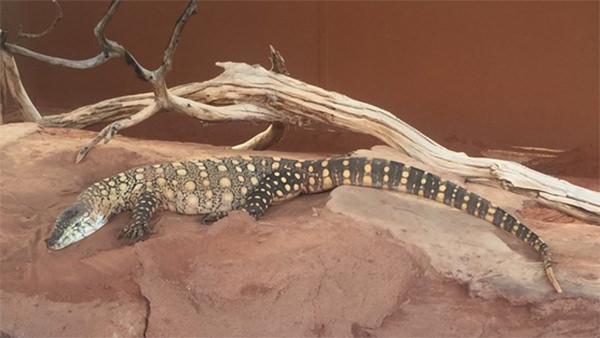
A respected animal of great cultural importance
In many Aboriginal cultures, the goanna is a Creator spirit in Dreamtime stories. Like other animals that are central to life, they also hold a totemic status, form part of ceremony and feature in parables ranging from how to conduct oneself to how and when to hunt.
For example, the Nyangbal people of the Bundjalung Nation believe that they are direct descendants of Dirawong the Ancestral goanna. If your totem is the goanna, there are clearly defined roles and responsibilities to ensure the conservation of this important animal. They include maintaining the Country so it is favourable to the species, as well as ensuring the songs, dances and stories about the Ancestral goanna are maintained.
The Wiradjuri people observe the goanna constellation and its location in the night sky. The constellation provides important information about the movement of the animal and maintaining its population. For example, when the constellation appears high in the sky, the Dreaming story explains the goanna is climbing a tree. This is not considered a good time for the animal to be hunted.
An important food source and bush medicine
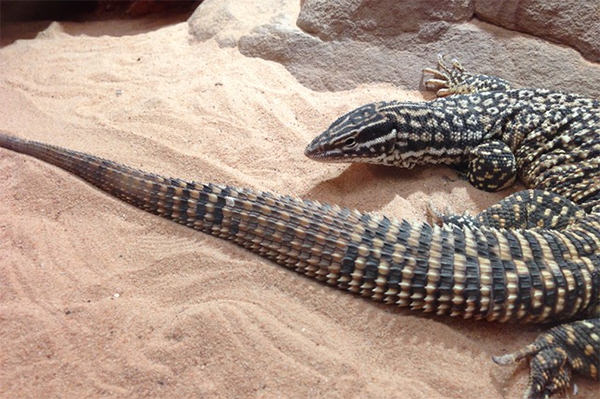
This animal is a very popular bush tucker throughout Australia, but particularly in desert areas where large animals are rare. The Martu women from the Western Desert use fire for hunting goanna. They set a fire line and clear off a track of old spinifex grass and follow in behind the flames. The women track the lizards to their burrows, where they excavate them with a long digging stick.
Traditionally the animal is cooked whole on the ashes and hot coal. It is a delicious oily white meat that tastes like chicken, and in some regions is fondly referred to as ‘KFG’ (Kentucky Fried Goanna). The fat and oil from the animal are used in traditional bush medicine.
Goannas featured in contemporary Aboriginal paintings
Representations of these animals are common in Indigenous artwork, not just as food, but also as a symbolic spiritual motif.
Some artists represent animals by the tracks they leave behind. Goannas leave distinctive tracks that include their feet and a winding tail-mark. Artist Debra Nangala McDonald paints a representation of a Goanna burrow.
The small central concentric circle represents the hole in the sandbank where the animal lives. The larger circle around it depicts the contours of the sandhill around the burrow.
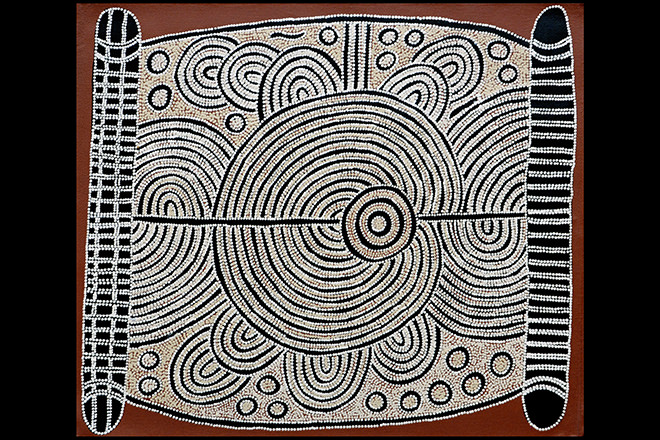 Goanna Love Story by Debra Nangala McDonald. The design relates to the Goanna Spirit of the Dreamtime as they travel their country in search of love.
Goanna Love Story by Debra Nangala McDonald. The design relates to the Goanna Spirit of the Dreamtime as they travel their country in search of love.
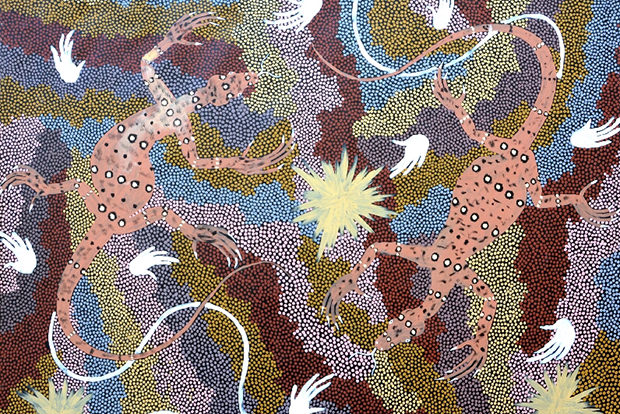
Clifford Possum depicts both the animal tracks and a figurative representation of the two Goanna Brothers at Yarumayi, about 20 kilometers east of Yuendumu. It is an epic Dreamtime story which begins in Mt Allan and involves an impressive chase past many important water soakage sites.
This artwork depicts the end of the Brother’s chase when they entered a low-lying rock outcrop near Mt Allan known as Warri Warri. The Ancestors eggs can be seen lying on top of this outcrop, metamorphosed into large round rocks which can be seen today.
Kathleen Buzzacott also uses Aboriginal symbols and figurative elements in her finely executed dot paintings to tell the story of families hunting the mighty Perentie.
U shapes represent women and children. Next to them are oval shapes and straight lines, which can represent the woman’s coolamon bowl and digging stick. The Perentie are painted representationally with exceptional attention given to their anatomical features.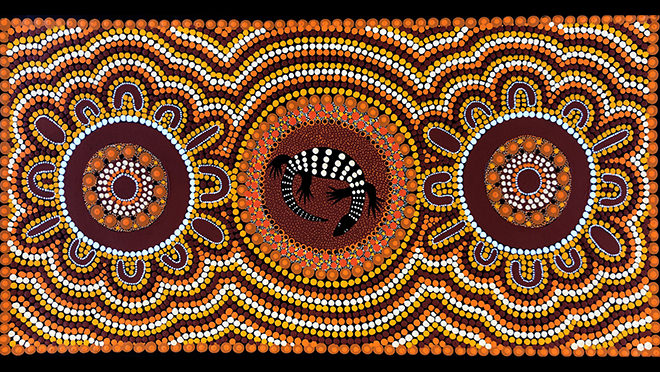
Our art gallery has a wonderful range of goanna Aboriginal art. Our vast collection of art also includes many other native Australian animals depicted in a wide variety of styles.
